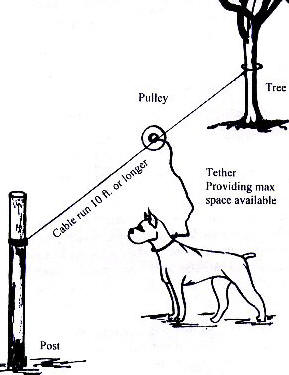Alternatives
Trolley, pulley, or cable run for your dog is one humane alternative. Here are come links to websites that offer step by step instructions for building your own.
http://jennaandsnickers.com/2013/07/cable-run/
http://homesteadchronicles.com/blog/installing-a-dog-run/
http://www.animalliberationfront.com/Practical/Pets/PetCare/
Facts About Chaining Dogs
“I deserve more than being a prisoner in your backyard.
Please give me some freedom!
”
Guard Dog, from Mutts comic strip
Unchain Your Dog
In the state of California it is illegal to tie your dog to any stationary object for more than a 3 hour period within 24 hours. Click here for a more details on this law.
What is meant by "chaining" or "tethering" dogs?
Generally speaking, the terms “tethering” and “chaining” refer to the practice of fastening a dog to a stationary object and leaving him unattended. The term “chaining” tends to refer to situations where thick, heavy chains are used. “Tethering” is more often referred to partial restraint on a rope, lighter chain or pulley, which is the more prevalent form of tethering. These terms are not meant to refer to an animal being walked on a leash, or cases of supervised, temporary tethering while an owner is present.
Why do people tether their dogs?
People tether their dogs for a variety of reasons. Most people who do this are unaware of the harm it can cause to their dogs. Social norms of pet-keeping have made tethering unpopular, so it is declining as a practice, but some reasons people do it include:
- The dog is a repeat escapee and the owner has run out of ideas to safely confine the dog. Sometimes this is the reason dogs are kept on heavier chains—they have chewed through or otherwise escaped lighter tethers and the owner is trying to keep them from getting loose.
- The owner is trying to protect his dog from something on the other side of their fence (kids, another dog, etc.) by keeping the dog in one area in the yard.
- The owner's fence is damaged, or the owner doesn't have a fenced yard.
- The dog's behavior makes keeping him indoors challenging, and the owner doesn't know how to correct the behavior.
- The landlord may not allow the pet owner to keep the dog indoors or install a fence.
- The pet owner comes from a family that always tethered dogs, and may never have realized there were better options.
Why is tethering bad for dogs?
Dogs are naturally social beings who need interaction with humans and/or other animals. Intensive confinement or long-term restraint can severely damage their physical and psychological well-being. An otherwise friendly and docile dog, when kept continuously chained or intensively confined in any way, becomes neurotic, unhappy, anxious and often aggressive.
It is common for continuously tethered dogs to endure physical ailments as a result of being continuously tethered. Their necks can become raw and sore, and their collars can painfully grow into their skin. They are vulnerable to insect bites and parasites, and are at high risk of entanglement, strangulation, and harassment or attacks by other dogs or people.
Tethered dogs may also suffer from irregular feedings, overturned water bowls, inadequate veterinary care and extreme temperatures. During snow storms, these dogs often have no access to shelter. During periods of extreme heat, they may not receive adequate water or protection from the sun. Owners who chain their dogs are less likely to clean the area of confinement, causing the dogs to eat and sleep in an area contaminated with urine and feces. What's more, because their often neurotic behavior makes them difficult to approach, chained dogs are rarely given even minimal affection. Tethered dogs may become "part of the scenery" and can be easily ignored by their owners.



